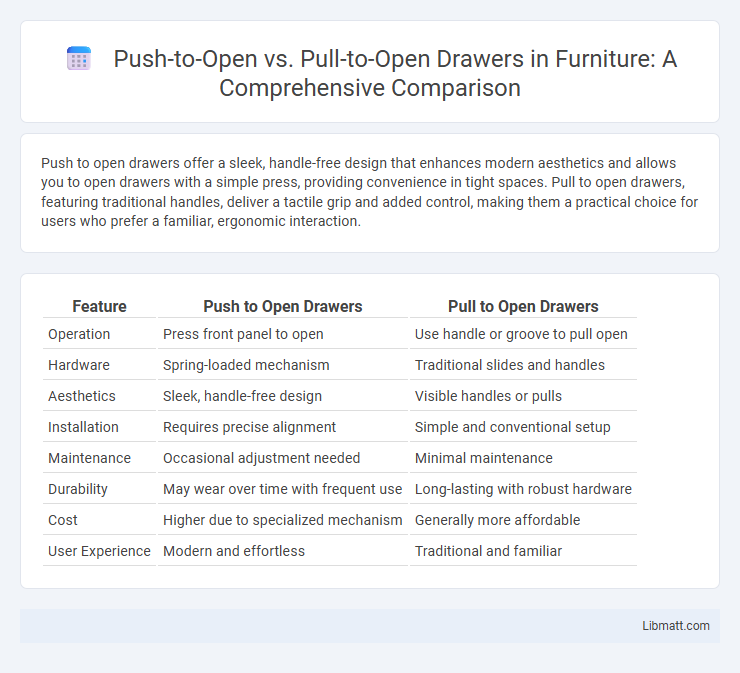Push to open drawers offer a sleek, handle-free design that enhances modern aesthetics and allows you to open drawers with a simple press, providing convenience in tight spaces. Pull to open drawers, featuring traditional handles, deliver a tactile grip and added control, making them a practical choice for users who prefer a familiar, ergonomic interaction.
Table of Comparison
| Feature | Push to Open Drawers | Pull to Open Drawers |
|---|---|---|
| Operation | Press front panel to open | Use handle or groove to pull open |
| Hardware | Spring-loaded mechanism | Traditional slides and handles |
| Aesthetics | Sleek, handle-free design | Visible handles or pulls |
| Installation | Requires precise alignment | Simple and conventional setup |
| Maintenance | Occasional adjustment needed | Minimal maintenance |
| Durability | May wear over time with frequent use | Long-lasting with robust hardware |
| Cost | Higher due to specialized mechanism | Generally more affordable |
| User Experience | Modern and effortless | Traditional and familiar |
Introduction to Drawer Mechanisms
Push to open drawers utilize a spring-loaded or soft-close mechanism that activates when the front panel is pressed, allowing for a sleek, handle-free design and easy access. Pull to open drawers rely on traditional handles or grooves that require manual pulling to open, offering straightforward operation but often compromising minimalist aesthetics. The choice between these mechanisms impacts both the functional convenience and the visual style of furniture in kitchens, offices, and living spaces.
What Is Push to Open?
Push to open is a modern drawer mechanism that allows drawers to open with a gentle push, eliminating the need for handles or knobs. This system relies on spring-loaded or mechanical latches that release the drawer when pressure is applied to the front panel, creating a sleek, handle-free aesthetic. Push to open offers a seamless, minimalist design ideal for contemporary kitchens and furniture, enhancing both functionality and style.
What Is Pull to Open?
Pull to open drawers feature handles or knobs that require users to grasp and pull them outward for access, providing a traditional and tactile method. This mechanism prioritizes ease of use and tactile feedback, making it simple to open drawers without applying pressure to the drawer front. Common in kitchens and furniture, pull to open designs offer reliable functionality and a classic aesthetic.
Design Differences: Push vs Pull
Push to open drawers feature a sleek, handle-free design with an internal spring mechanism that activates when pressure is applied, enabling a minimalist aesthetic and seamless integration with cabinetry. Pull to open drawers rely on external handles or knobs, offering a tactile grip and traditional appearance that complements various interior styles. The choice between push and pull designs significantly impacts kitchen ergonomics, style consistency, and ease of use.
Installation and Compatibility
Push to open drawers offer a sleek, handle-free design that requires precise alignment during installation to ensure smooth operation, often compatible with soft-close mechanisms for enhanced functionality. Pull to open drawers provide greater installation flexibility, as standard drawer slides readily support various handle types and thicknesses, making them compatible with most cabinetry designs. Both systems require measuring drawer front thickness and cabinet depth to select appropriate hardware, ensuring seamless integration and optimal performance.
Ease of Use and Accessibility
Push to open drawers enhance ease of use by allowing hands-free operation, ideal for individuals with limited dexterity or when hands are full. Pull to open drawers provide tactile feedback and require less precision, benefiting users who prefer physical handles for better grip and accessibility. Both mechanisms improve accessibility but cater to different user needs, with push to open favoring seamless access and pull to open offering intuitive control.
Durability and Maintenance
Push to open drawers feature a mechanism that can wear out over time due to constant pressure on springs or sensors, requiring occasional adjustments or replacements for optimal performance. Pull to open drawers rely on sturdy handles or knobs, which tend to have less mechanical wear but may show cosmetic wear from frequent use. Your choice affects long-term durability and maintenance needs, with pull to open generally demanding less frequent repairs but push to open offering a cleaner, handle-free aesthetic.
Cost Comparison
Push to open drawers generally have higher upfront costs due to the need for specialized mechanisms, while pull to open drawers feature simpler hardware that tends to be more budget-friendly. Maintenance expenses for push to open systems can also be higher, as their spring or magnet-based components may wear out or fail over time. Your choice between these options should consider both installation costs and long-term durability for optimal value.
Best Applications for Each Mechanism
Push to open drawers are ideal for modern kitchens and minimalist designs where handles disrupt clean lines, offering effortless access with a simple press, especially in cabinetry with soft-close mechanisms. Pull to open drawers remain the best choice for heavy-duty applications like workshop or garage storage, providing a secure grip and better control when handling heavier or frequently accessed items. In high-traffic areas such as offices or commercial spaces, pull drawers help improve efficiency as they require less precision and are familiar to most users.
Choosing the Right Drawer System
Choosing the right drawer system depends on functionality and design preferences, with push to open drawers offering a sleek, handle-free look ideal for modern kitchens, while pull to open drawers provide tactile feedback and may accommodate heavier loads more easily. Push to open mechanisms typically require precise installation and regular maintenance to ensure optimal responsiveness, whereas pull to open drawers are simpler, relying on traditional handles or pulls for operation. Consider the frequency of use, ergonomic comfort, and aesthetic integration with cabinet styles to select the most suitable drawer system for your space.
push to open vs pull to open drawers Infographic

 libmatt.com
libmatt.com